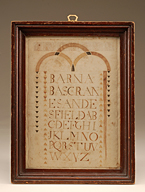| Maker(s): | Crane, Barnabas
| | Culture: | American (1781-1857)
| | Title: | calligraphy sampler
| | Date Made: | ca. 1790
| | Type: | Documentary Artifact
| | Materials: | paper, ink, watercolor, wood, stain, glass
| | Place Made: | United States; Massachusetts; Sandisfield
| | Measurements: | Sheet: 11 x 7 1/2 in; 27.9 x 19 cm
| | Accession Number: | HD 2007.14.2
| | Credit Line: | Museum Collections Fund
| | Museum Collection: | Historic Deerfield
|
|

|
Description:
Framed calligraphy sampler on laid paper in a period, red-stained, molded wooden frame, which has three arches over eight lines of capital letters: "BARNA / BASCRAN / ESANDE / SFIELDAB / CDEFGHL / JKLMNO / PQRSTUV / WXYZ." The sampler was drawn by Barnabas Crane (1781-1857) of Sandisfield (located in Berkshire County, just to the east of Great Barrington, Massachusetts). Barnabas was the fifth of twelve children of Elijah Crane (1744-1806) and Martha Bush Crane (b.c.1749) of Sandisfield. These alphabet samplers were probably early exercises in teaching students how to print letters with a pen on paper. Instruction in writing began around the age of eight to ten years of age, when young hands were deemed able to handle paper, ink, and a quill pen. Unlike reading, instruction in writing was taught by men. Although created by a boy, Crane’s sampler has a similar appearance to contemporary schoolgirl needlework samplers. Barnabas executed this calligraphic sampler to showcase his budding literacy skills, his steady writing hand, and his sense of overall design, incorporating an unadorned text block within a double-arched frame and border of triangle-shaped elements. Whereas boys occasionally embroidered samplers, they also hand-lettered calligraphic examples, following the form of embroidered samplers. Distinguishing his design from embroidered samplers produced by young women, he avoided foliate, floral and pictorial motifs. As in some text-only samplers and on some tombstones, he wrapped the text to subsequent lines without regard for customary rules of word division. This strategy visually dissociated meaning from lettering, emphasizing consistency of spacing and letter formation. In addition to demonstrating mastery of the pen, perhaps he intended his work as a teaching aid for younger siblings learning to sound-out the alphabet, recognize the written form of their brother’s first name, their family surname and the name of their home town. See also the penmanship exercise (HD 2001.23) by Isaac Shepard Jr. of Ashfield, Mass.
Link to share this object record:
https://museums.fivecolleges.edu/detail.php?t=objects&type=ext&id_number=HD+2007.14.2 |